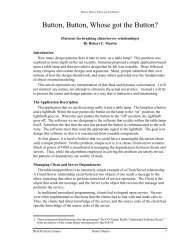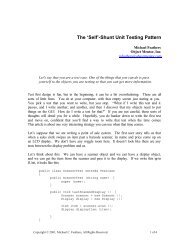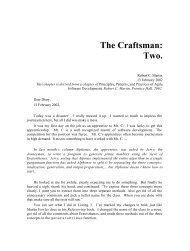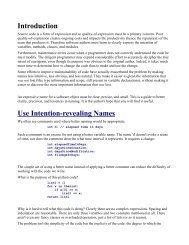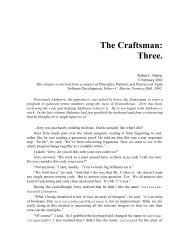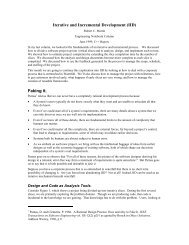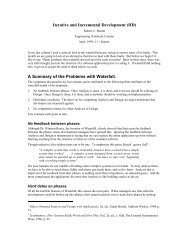The Craftsman: 7 SocketService 2 - Object Mentor
The Craftsman: 7 SocketService 2 - Object Mentor
The Craftsman: 7 SocketService 2 - Object Mentor
You also want an ePaper? Increase the reach of your titles
YUMPU automatically turns print PDFs into web optimized ePapers that Google loves.
<strong>The</strong> <strong>Craftsman</strong>: 7<strong>SocketService</strong> 2Robert C. Martin15 Oct 2002Last time, Alphonse and Jerry started working on a simple java framework for supporting socketservices. <strong>The</strong>ir first test case uncovered a race condition that they were able to resolve. <strong>The</strong> current suiteof unit tests is shown in Listing 1, and the production code is in Listing 2.import junit.framework.TestCase;import junit.swingui.TestRunner;import java.io.IOException;import java.net.Socket;Listing 1.public class TestSocketServer extends TestCase {public static void main(String[] args) {TestRunner.main(new String[]{"TestSocketServer"});}}public TestSocketServer(String name) {super(name);}public void testOneConnection() throws Exception {<strong>SocketService</strong> ss = new <strong>SocketService</strong>();ss.serve(999);connect(999);ss.close();assertEquals(1, ss.connections());}private void connect(int port) {try {Socket s = new Socket("localhost", port);try {Thread.sleep(100);} catch (InterruptedException e) {}s.close();} catch (IOException e) {fail("could not connect");}}
import java.io.IOException;import java.net.*;Listing 2.public class <strong>SocketService</strong> {private ServerSocket serverSocket = null;private int connections = 0;private Thread serverThread = null;}public void serve(int port) throws Exception {serverSocket = new ServerSocket(port);serverThread = new Thread(new Runnable() {public void run() {try {Socket s = serverSocket.accept();s.close();connections++;} catch (IOException e) {}}});serverThread.start();}public void close() throws Exception {serverSocket.close();}public int connections() {return connections;}We came back from our break, ready to continue the <strong>SocketService</strong>.“We’ve proven that we can connect once. Lets try to connect several times.” said Jerry.“Sounds good.” I said. So I wrote the following test case.public void testManyConnections() throws Exception {<strong>SocketService</strong> ss = new <strong>SocketService</strong>();ss.serve(999);for (int i = 0; i < 10; i++)connect(999);ss.close();assertEquals(10, ss.connections());}“OK, this fails.” I said.“As it should.” Jerry replied. “<strong>The</strong> <strong>SocketService</strong> only calls accept once. We need to put that callinto a loop.”“When should the loop terminate?” I asked.Jerry thought for a second and said: “When we call close on the <strong>SocketService</strong>.”.“Like this?” And I made the following changes:public class <strong>SocketService</strong> {
}private ServerSocket serverSocket = null;private int connections = 0;private Thread serverThread = null;private boolean running = false;public void serve(int port) throws Exception {serverSocket = new ServerSocket(port);serverThread = new Thread(new Runnable() {public void run() {running = true;while (running) {try {Socket s = serverSocket.accept();s.close();connections++;} catch (IOException e) {}}}});serverThread.start();}public void close() throws Exception {running = false;serverSocket.close();}I ran the tests, and they both passed.“Good.” I said. “Now we can connect as many times as we like. Unfortunately the <strong>SocketService</strong>doesn’t do very much when we connect to it. It just closes.”“Yeah, let’s change that.” said Jerry. “Lets have the <strong>SocketService</strong> send us a “Hello” messagewhen we connect to it.”I didn’t care for that. I said: “Why should we pollute <strong>SocketService</strong> with a “Hello” message just tosatisfy our tests? It would be good to test that the <strong>SocketService</strong> can send a message, but we don’t wantthe message to be part of the <strong>SocketService</strong> code!”“Right!” Jerry agreed. “We want the message to be specified by, and verified by, the test.”“How do we do that?” I asked.Jerry smiled and said: “We’ll use the Mock <strong>Object</strong> pattern. In short, we create an interface that the<strong>SocketService</strong> will execute after receiving a connection. We’ll have the test implement that interface tosend the “Hello” message. <strong>The</strong>n we’ll have the test read the message from the client socket and verify thatit was sent correctly.”I didn’t know what the Mock <strong>Object</strong> pattern was, and his description of interfaces confused me. “Canyou show me?” I asked.So Jerry took the keyboard and began to type.“First we’ll write the test.”public void testSendMessage() throws Exception{<strong>SocketService</strong> ss = new <strong>SocketService</strong>();ss.serve(999, new HelloServer());Socket s = new Socket("localhost", 999);
}}});private void acceptAndServeConnection() {try {Socket s = serverSocket.accept();itsServer.serve(s);s.close();} catch (IOException e) {}}public void close() throws Exception {running = false;serverSocket.close();}




